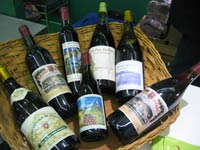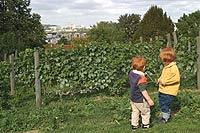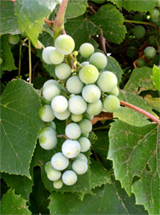|

The
New Vines of Paris and Ile-de-France
Reviving
Old Traditions
|
The
"New" Parisian Vineyard |
Is
wine a product of culture? While such a concept may seem comical
to some, wine producers in Ile-de-France
think otherwise. Winemaking in Paris and in the surrounding region
is not lucrative due to the absence of vine-planting rights, which
means that wine produced here cannot be sold in commercial markets.
Why
then have all of these individuals, associations and municipalities,
for more than forty years, been multiplying vineyards (150 to be
exact) on over eleven hectares of land? In addition to there being
a cultural objective, there is also a patrimonial and pedagogical
motivation behind their activity. Remembering the long history of
wine in Paris and its surrounding region, reviving that tradition
seems especially important today, since wine is no longer only a
question of label or grape variety but an essential element of the
"art de vivre" of our civilization.
 |
| Wines
of Paris and Ile-de-France |
In
an effort to promote suburban "crus," L'Association Vignerons
Franciliens Réunis (VFR), the Association of Francilien Wine
Producers, comprised of inhabitants of the Ile-de-France region,
has put together a tourist map listing almost a hundred winemaking
and tasting circuits in the region. And why not? After all, Haut-Brion
in Bordeaux,
Noble-Joué in Tours and Bellet in Nice
are all wines from suburbs of large cities!
The new vineyard in Paris is part of the folklore of the charming
hilltop neighborhood of Montmarte. Souvenir and symbol of the omnipresent
vine in Ile-de-France, the picturesque Clos Montmartre, replanted
in 1933, contains 1,900 vines of twenty-eight different grape varieties
including 75% Gamay and 20% Pinot Noir. With a production of 1,700
bottles per year, this wine, unavailable on the market, is reserved
for the use of the 18th arrondissement's City Hall. In the past,
this wine was considered to be rough swill possessing diuretic qualities,
yet more recently it was recognized during a symposium on wines
from Ile-de-France.
Next,
there is the wine of the elevated, Seine-side suburb of Suresnes,
replanted in 1965 and composed of one hectare of Chardonnay, Sauvignon
Blanc and a bit of Sémillon. In nearby Issy-les-Moulineaux,
a spectacular effort has been made by Yves Legrand, owner of local
chalk quarries. His white wine, Le Clos des Moulineaux 1995, received
first prize in a 1996 contest of wines from Ile-de-France. This
"vineyard," revived in the late 1980's, is composed of
a small plot of land with 265 vines, two hundred of which are Chardonnay
and sixty-five are Pinot Beurot, or blush grapes. The "vendange,"
or harvest, is accomplished each year by a group of fifth-graders
as part of their ecology education. The winemaking process is overseen
by Legrand, and ageing is done in oak barrels. A dry white with
well-developed floral notes, the 2000 harvest is still pleasant
to drink, although one shouldn't expect too much originality from
this wine, whose grapes are grown practically under the RER train
tracks. Each bottle, cheerfully illustrated with a student's drawing,
is sold at the Caves Yves Legrand in Issy-les-Moulineaux for 15
euros, which is donated to the town's education treasury. The wine
is also available at Apicius
in Paris.
 |
| Kids
Take Care of the "Vendange" in Issy-les-Moulineaux |
At
the Clos des Morillons in the Square Georges-Brassens, the harvest
happens every year, and, like in other wine-producing areas of Paris
such as Bercy and Belleville, it's quite a festive event. If you're
around during the fall harvest, don't miss the vendage party at
Chez
Mélac, a wine bistro on the rue Léon Frot in the
11th arrondissement. The Morillon is an old-fashioned Pinot Noir
grape present in Ile-de-France and in the Champagne
region, where it is harvested earlier than its Burgundian variety.
It was cultivated in the 16th century as a grape for eating and
today lends a light color to its cherry-perfumed wines ; and while
it does not last long in the mouth, it possesses a delicate flavor.
Drinking wines from Ile-de-France is, more than anything else, a
symbolic gesture, a salute to its rich historic past.
The
map is available for free at tourist offices. More information at
www.vigneronsfranciliens.com.
| Wines
from Paris and Ile-de-France |
Les
Vignerons Franciliens
Réunis (VFR)
75, rue de la Fontaine au Roi
75011 Paris
Tel: 01 49 29 75 61
Fax: 01 49 29 75 65
contact@vigneronsfranciliens.com
www.vigneronsfranciliens.com
Caves
Yves Legrand
113 bis, avenue de Verdun
92130 Issy-les-Moulineaux
Tel: 01 46 38 90 51
Chez
Mélac
42, rue Léon Frot
Tel: 01 43 70 59 27
Clos
Montmartre
Rue Saint Vincent
Tel: 01 47 00 50 81
Clos
Morillons
50 rue des Morillons
Tel: 01 48 28 04 37 |
 |
|
 Return
to Features
Return
to Features
 European
Wine Selections
European
Wine Selections
 World
Map of Winery Organizations
World
Map of Winery Organizations
*
Images courtesy of Les Vignerons Franciliens Réunis
| PJCR |
(Updated:
02/27/09 SV) |
|
